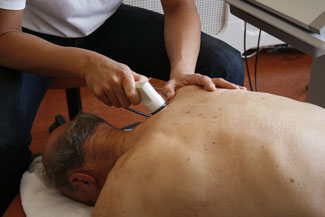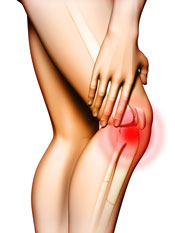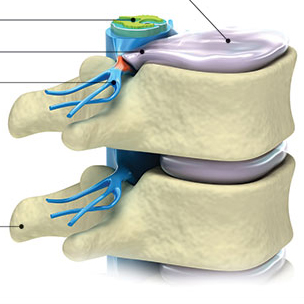Non Surgical Options
The trend in orthopedics and spine is for a specialist to exhaust all non-surgical treatment options in advance of surgery. That’s because the more invasive (surgical) the treatment option, the more tissue is disrupted and there is more potential for more complications than with therapy or a injection.
For example, with back pain, including low back pain, and neck pain, non-surgical treatment is very important because spine surgery is complex, often requiring an overnight stay in the hospital. To gain access to the spine the spine surgeon, may need to access the spine through the abdomen or back, which can require disruption to tissues and muscles, which in turn causes time for recovery and rehabilitation. Also, many times symptoms from disc herniations can disappear with non-surgical treatment options.
 So if you are impatient, wanting a quick fix to your problem, keep in mind that the best specialists in orthopedics, sports medicine and spine will first look at if there are non-surgical options for you to try first before surgery.
So if you are impatient, wanting a quick fix to your problem, keep in mind that the best specialists in orthopedics, sports medicine and spine will first look at if there are non-surgical options for you to try first before surgery.
With sports medicine problems involving strain, sprain or overuse syndrome, non-surgical treatment options like anti-inflammatory medication, injections into a joint space or specialist therapy, can many times provide relief of symptoms without the need for surgery.
The other aspect to non-surgical emphasis can be to address the underlying cause of your pain symptoms. In the United States, for example, research studies have shown that half of the population is overweight, and one in four Americans is categorized as “obese.” The grim reality is that the human knee, for example, was never designed to support a 350 pound person. Over time, excess weight will simply destroy a knee joint, requiring knee replacement. But merely replacing that knee joint, without addressing the obesity causing the problem, will in turn destroy the new artificial knee joint. Because of the nature of a knee replacement surgery, a person can typically have only two knee replacements in their lifetime before they become wheelchair bound.
Diagnosing a Shoulder Problem
The orthopaedic specialists will order x-rays to help diagnose your condition. While relatively rare, arthritis is best seen with plain x-rays. The orthopaedic specialist may order an MRI to see if there is a problem that requires surgery.
About Nonsurgical Care
The specialist may recommend a series of exercises to strengthen the muscles around the shoulder. A skilled physical therapist can help educate you in this program and make sure the exercises are done properly. This can restore stability and balance to the shoulder and provide relief from pain and instability.
Non-steroidal anti-inflammatory medicines (i.e. ibuprofen) can help with the pain and inflammation. Steroid injections can be very effective at rapidly reducing inflammation and pain, making the rehab process easier.
Pain Prevention
A person can lower their risk of injuries to the shoulder by addressing the following areas:
Technique & form
If you use the correct technique, you achieve power correctly rather than through counter productive and excessive body movements and torque. An incorrect swing in tennis, often indicates that the person is relying only on the arm to hit the ball, rather than transfer of body weight and uncoiling the trunk correctly.
Failure to warm up and cool down
Warming up and cooling down is extremely important to reduce the risk of muscle and joint injuries. Warming up will not only help avoid injury but will also improve performance.
Stress fractures
Repetitive stressful motion on a leg or arm can over time create a painful stress fracture. In a leg, this can include a spiral fracture where the crack in the bone resembles a spiral staircase. These can be difficult injuries to recover from.
Overuse syndrome
 Your body needs recovery time between events. This is common problem with Spring training in baseball, where teen athletes throw for three hours straight in practice sessions, only to tear a rotator cuff, or create a ligament strain in the elbow.
Your body needs recovery time between events. This is common problem with Spring training in baseball, where teen athletes throw for three hours straight in practice sessions, only to tear a rotator cuff, or create a ligament strain in the elbow.
Refrain from any activity that causes shoulder pain. Give it a rest and find an alternate activity or exercise that does not cause the pain.
Recurrent injury
Many times people never fully give themselves time to recover from an earlier strain or sprain, and this can lead to similar strain in the future.
Good posture
Keep your shoulders slightly back and your head up to prevent shoulder pain. When your shoulders slump forward this can lead to increased pain in the joints.
Ergonomics
Prevent shoulder pain when working at a desk or computer by positioning your keyboard and mouse so that your arms can be relaxed at your side. There should be a slightly open angle at the elbow and the wrists should be straight.
If you work at a computer during the day, taking short breaks every half hour can help rest your neck and shoulders. For example, you can cross your arms and place them on your desk. Then rest your forehead on your arms to allow your shoulders to relax.
When surgery is the best route
 When there is a fracture, completely torn ligament (e.g. torn anterior cruciate ligament in the knee), or a badly degenerated joint (e.g. arthritic hip joint or damaged knee joint), or a badly herniated disc, the only real option may be surgery.
When there is a fracture, completely torn ligament (e.g. torn anterior cruciate ligament in the knee), or a badly degenerated joint (e.g. arthritic hip joint or damaged knee joint), or a badly herniated disc, the only real option may be surgery.
Also, if you have tried therapy and injections for two months, then the next step may be surgery to resolve your problem and get you back to activity.
We understand that you are eager to get back to activity and we will help you reach that goal. Keep in mind that we are recommending the best long term options for your care. We are on your team for the long haul!








